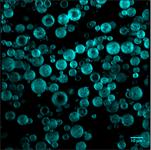
We are all aware that the number of people within the UK and much of the world who are overweight or obese is increasing. This is reflected within media coverage, consumer awareness and government focus. Pressures from consumers and government (notably the Department of Health Public Health Responsibility Deal collective pledges) means that the food industry is working towards designing and producing foods which have a more positive impact on health and nutrition. This has translated into funding opportunities coming from both industry and government research councils.
Clearly, obesity is a complex issue, and tackling it involves a combination of better education, better regulations on advertising and labelling of food products, and an increase in physical activity, all of which require input from experts and knowledge from many disciplines. There is certainly a need for food scientists and chemical engineers to understand how we can design and manufacture foods that are healthier, taste great, and even deliver functionality.
Despite the fact that we eat in order to provide our body with energy and nutrients, the amount of enjoyment that we get from the food is often the governing factor in our decisions to consume food. The modern world has been described as obesiogenic: consumers have a wide variety of tasty, possibly unhealthy, foods that are readily available. Food products that are high in fat, salt and sugar also tend to taste better, which is as a result of the way we have learnt to associate particular tastes with high energy density: our bodies encourage us to feast on high energy foods in anticipation of famines as this offers us evolutionary advantage. Low fat / sugar / calorie foods often do not have the same sensory impact or palatability.
Within the School of Chemical Engineering at the University of Birmingham we are working on a number of projects that aim to reduce the fat, sugar or salt of products, investigate ways to sustain the release or target the release of nutrients to particular parts of the digestive system, or see how foods might have a positive effect on appetite (either making us feel fuller quicker, or fuller for longer). I am personally particularly interested in how food structure can impact upon the sensory perception (taste, flavour and mouthfeel) and palatability of food products, in addition to appetite. For instance, we have shown that by changing the size of droplets within an emulsion (whilst keeping the ingredients the same) we can impact upon sensory attributes such as creaminess, which could also make people feel fuller for longer (creaminess has been shown by other researchers to be a cue for satiety).

It is also a fairly new and novel area of research, meaning that there is scope to explore not only the design of foods (taking into account formulation and processing), but to better understand what it is about the structure that makes the food pleasurable to eat. This type of research is also different from research typically conducted in engineering departments – it puts the consumer at the forefront of the research. I was fortunate to get an opportunity to design a food grade kitchen within Chemical Engineering, meaning that there is scope for conducting exciting research in Birmingham. The facility enables us to produce foods that we can then give to consumers to eat, allowing us to gain an understanding of the effect that our manipulations have on sensory scores and appetite ratings.
I find this area of research really exciting and challenging; not only is it interesting from a fundamental, scientific point of view, but it could also have a huge, positive impact on the health and well being of many people.
Image:3D projection of water in oil emulsion stabilised by fat “shell” dyed with a mixture of Nile blue and Nile red (confocal). Provided by Richard Watson and Lucie Villedieu.
Dr Jennifer Norton is a Research Fellow in the School of Chemical Engineering